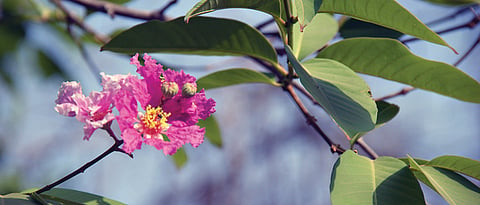

On a bright Sunday morning on April 15, the Puneri Wikipedia of trees — botanist S D Mahajan, led a group of 125 people around Savitribai Phule Pune University. The event was organised by the NGO Maharashtra Vruksha Samvardhini, of which Mahajan is the president, to create awareness about different species of trees.
The walk began at the immense katesavar outside the main building of the university campus, which, according to Mahajan, has possibly been growing there for 150-200 years. “This tree was so big even 60 years ago when I studied here,” the professor explained. The various names of the tree danced off his tongue: bombax ceiba, cotton tree, semal, shalmali malbarika and so on.
He introduced the tree to his rapt listeners like a person with great affinity, knowledge and understanding. “The leaves of katesavar are edible. Deer, rabbits and squirrels congregate to eat it. Tribals use it as a vegetable. And the sap has medicinal properties,” Mahajan informed.
He dedicatedly led the tree lovers and enthusiasts around the campus for over an hour, gently introducing a mix of indigenous and alien trees. He spoke about the patangi, tamarind, tamhan, nagphani along with 15 other species, explaining the meaning of the names of the trees, their use, their geographical spread, and their relevance in mythology. But repeatedly, he made just one earnest plea: plant more indigenous trees, not alien ones.
“For the last 25 years, we have been saying plant indigenous trees. Alien species are bad for the environment. For instance, the gulmohar (delonix regia) is an alien species. It is from Madagascar. Why do you think it grows here more than there? Because it doesn’t have enemies here,” Mahajan said. Alien species tend to be aggressive and take over the land from indigenous species, unbalancing the ecology of the region, he added.
“Instead, trees like katesavar, bahava must be planted in large numbers,” said the author of the popular book Deshi Vruksha.
The magnificent katesavar
Just as he explained this, he pointed to an example of an indigenous tree taking over a foreign species: a peepal tree (ficus religiosa) was growing prodigiously on a jacaranda tree. “The peepal understands that we don’t need a jacaranda tree, but we don’t,” he joked.
One of the participants Nandini Devi Pantpratinidhi, an environment enthusiast, listened to Mahajan, who is also her mentor. “I have grown up in forests, yet he articulates what I think. I am fighting for the forests now,” she shared after she had finished collecting a handful of seeds of the baheda tree.
Another participant Mukta Asnikar also collected the seeds. “When I saw a tree being cut, I was very disturbed. So I’m trying to learn about trees now,” she shared.
Come monsoon, several enthusiasts will race to plant trees. “The mistake of introducing alien trees in Pune was made 40-50 years ago. So now we want to generate awareness about indigenous and alien trees,” said Pramod Behere, the treasurer of the NGO. He added, “We urge enthusiasts that they shouldn’t stop at just observing trees. This is a big movement which requires everyone’s strength.”
